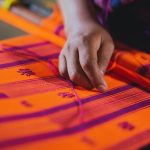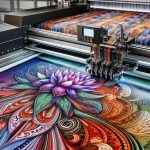Are you unsure about which ink to use for your fabric silk screen prints? Look no further! In this article, we will explore the different types of inks available and help you determine which one is better suited for your needs.
From water-based inks to discharge inks, we will break down the pros and cons of each option.
So, get ready to discover the perfect ink for your fabric silk screen prints!
Table of Contents
Types of Inks for Fabric Silk Screen Print
If you’re looking for the best ink for fabric silk screen print, water-based inks are a popular choice. When it comes to fabric printing, there are two main types of inks to consider: water-based inks and plastisol inks.
Water-based inks are made up of pigments suspended in a water-based solution, while plastisol inks are made up of PVC particles suspended in a plasticizer.
One advantage of water-based inks is that they are more environmentally friendly compared to plastisol inks. Water-based inks do not contain harmful chemicals such as phthalates or lead, making them safer for both the environment and the people who handle them. Additionally, water-based inks are known for their vibrant colors and soft feel on the fabric. They are also more breathable, which is ideal for garments that will be worn for long periods of time.
Another advantage of water-based inks is that they have excellent washability. They adhere well to the fabric, resulting in prints that can withstand numerous wash cycles without fading or cracking. This makes water-based inks a great choice for creating durable and long-lasting designs on fabric.
Water-based Inks for Fabric Silk Screen Print
When considering water-based inks for fabric silk screen print, there are several important factors to consider.
First, you’ll want to evaluate the durability of water-based inks compared to other types of inks.
Additionally, it’s essential to assess the environmental impact of using water-based inks, as they are often touted as a more eco-friendly option.
Lastly, it’s worth examining the color vibrancy of water-based inks and how they compare to other ink types in terms of achieving vibrant and long-lasting colors on fabric.
Durability of Water-Based Inks
To ensure the longevity of your fabric silk screen print, you should consider using water-based inks due to their durability. Water-based inks are known for their ability to withstand regular washing and wear, making them an ideal choice for fabric printing.
Here are some benefits of using water-based inks on different fabric types:
-
Cotton: Water-based inks penetrate the fibers of cotton fabric, resulting in vibrant and long-lasting prints. They also retain the softness and breathability of the fabric.
-
Polyester: Water-based inks adhere well to polyester fabric, providing excellent color saturation and resistance to cracking or peeling.
-
Blends: Water-based inks can be used on fabric blends, ensuring consistent color and durability across different fibers.
Overall, water-based inks offer exceptional durability and washability, making them a reliable choice for your fabric silk screen prints.
Environmental Impact of Water-Based Inks
Water-based inks are environmentally friendly due to their low levels of volatile organic compounds. When compared to solvent-based inks, water-based inks have a much smaller impact on the environment. Solvent-based inks contain high levels of harmful chemicals that can be released into the atmosphere during the printing process. These chemicals not only contribute to air pollution but also pose health risks to workers handling the inks.
In contrast, water-based inks are made from non-toxic and biodegradable materials, making them a safer choice for both the environment and human health. Additionally, water-based inks are less likely to cause damage to fabrics. The chemicals in solvent-based inks can weaken the fibers of the fabric, leading to a shorter lifespan for the printed design. On the other hand, water-based inks bond with the fabric, resulting in a longer-lasting and more durable print.
Overall, choosing water-based inks over solvent-based inks is not only better for the environment but also ensures a higher quality and longer-lasting print on fabric.
Color Vibrancy Comparison?
If you want vibrant colors that really stand out, you should consider using water-based inks. These inks are known for their ability to produce bold and eye-catching hues on fabric. Here’s why water-based inks are a great choice:
-
Color fastness: Water-based inks have excellent color fastness, meaning that the colors will remain vibrant and won’t fade easily, even after multiple washes. This ensures that your designs stay vibrant and eye-catching for a long time.
-
Minimal dye migration: Water-based inks have a lower risk of dye migration compared to other types of inks. Dye migration happens when the dye molecules in the ink spread and bleed into adjacent areas, causing color distortion. By using water-based inks, you can minimize this issue and achieve cleaner and more precise prints.
-
Environmentally friendly: Water-based inks are also eco-friendly as they are free from harmful chemicals and solvents. They are non-toxic and have a lower impact on the environment compared to other types of inks.
Plastisol Inks for Fabric Silk Screen Print
When it comes to fabric silk screen printing, you may be wondering whether to use plastisol or water-based inks.
Plastisol inks are known for their durability, making them a popular choice for long-lasting prints.
However, it’s important to weigh the pros and cons of each type of ink to make an informed decision.
Plastisol Vs. Water-Based Inks
Plastisol inks are often preferred for fabric silk screen printing due to their durability and vibrant colors. Here are some pros and cons of plastisol inks for fabric silk screen print:
-
Pros:
-
Plastisol inks have excellent opacity, making them ideal for printing on dark fabrics.
-
They are highly durable and can withstand repeated washings without fading or cracking.
-
Plastisol inks have a long shelf life and can be stored for extended periods without drying out.
-
Cons:
-
Plastisol inks contain PVC and phthalates, which can be harmful to the environment and human health.
-
They require the use of solvents for cleanup, which can be messy and time-consuming.
-
Plastisol inks have a thicker consistency, which can result in a slightly raised texture on the printed fabric.
When comparing the cost effectiveness of plastisol and water-based inks for fabric silk screen print, plastisol inks are generally more cost-effective. They have a lower upfront cost and require less ink for printing, resulting in less waste. However, water-based inks are considered more environmentally friendly and offer a softer hand feel on the fabric. Ultimately, the choice between plastisol and water-based inks depends on the specific requirements and preferences of the print job.
Durability of Plastisol Inks
To ensure the longevity of your prints, make sure you properly cure the plastisol inks.
Plastisol inks are known for their durability, making them a popular choice for fabric silk screen printing. These inks create a strong bond with the fabric, resulting in prints that can withstand repeated washings without fading or cracking.
Compared to other types of inks, plastisol inks are more cost-effective in the long run. While they may have a higher upfront cost, their durability means that you won’t have to reprint or replace garments as frequently. This can save you money in the long term, making plastisol inks a smart investment for your printing business.
Discharge Inks for Fabric Silk Screen Print
Discharge inks are a popular choice for fabric silk screen prints. They offer a unique and versatile option for creating vibrant and soft designs on fabric.
Here are some key points to consider about the discharge ink process and the pros and cons of using discharge inks:
-
Discharge ink process:
-
Discharge inks work by removing the existing color from the fabric and replacing it with a new color.
-
The ink contains an activator that removes the dye from the fabric when heated, leaving behind a lighter base color.
-
The new color is then applied to the fabric, resulting in a vibrant and soft print.
-
Pros of using discharge inks:
-
Discharge inks produce a soft and breathable print, as the ink becomes part of the fabric rather than sitting on top.
-
They allow for intricate and detailed designs, as the ink can be easily absorbed into the fabric.
-
Discharge inks can create a unique vintage or distressed look, as they can remove the existing color from the fabric.
-
Cons of using discharge inks:
-
Discharge inks are best suited for lighter-colored fabrics, as they may not work as effectively on dark or heavily dyed fabrics.
-
The discharge process can be time-consuming and requires careful attention to temperature and timing.
-
The activator used in discharge inks can have a strong odor, so proper ventilation is necessary.
Overall, discharge inks offer a great option for fabric silk screen prints, providing a soft and vibrant result with the potential for unique designs. However, it’s important to consider the specific requirements and limitations of the fabric and design before choosing to use discharge inks.
Pigment Inks for Fabric Silk Screen Print
Pigment inks, like discharge inks, offer a versatile option for creating vibrant and soft designs on fabric. Unlike other types of inks, pigment inks are made up of tiny colored particles suspended in a liquid base. This allows the ink to sit on top of the fabric instead of being absorbed into the fibers, resulting in brighter and more vibrant colors.
One of the main benefits of using pigment inks is their ability to retain their color over time. Because the ink sits on top of the fabric, it is less likely to fade or wash out, making it ideal for long-lasting designs. Pigment inks also offer excellent coverage, meaning you can achieve bold and opaque designs with just one layer of ink.
To help you understand the benefits of pigment inks compared to other types of inks, here is a comparison table:
| Ink Type | Benefits |
|---|---|
| Pigment | Vibrant colors, excellent coverage, long-lasting |
| Discharge | Soft feel, bleach-like effect, suitable for dark fabrics |
| Water-based | Eco-friendly, easy to clean, suitable for light fabrics |
| Plastisol | Durable, good for large production runs, vibrant colors |
As you can see, pigment inks offer unique advantages for fabric silk screen printing. Whether you want vibrant colors or long-lasting designs, pigment inks are a great choice.
Metallic Inks for Fabric Silk Screen Print
Metallic inks, like pigment inks, offer a shimmering option for adding a touch of elegance to fabric silk screen prints. They have several advantages over other types of inks, making them a popular choice among artists and designers.
Advantages of Metallic Inks:
- Enhanced Visual Appeal: Metallic inks create a stunning visual effect on fabric, giving the prints a luxurious and eye-catching appearance.
- Durability: These inks are designed to withstand multiple washes without fading or losing their metallic sheen, ensuring longevity and quality.
- Versatility: Metallic inks are available in a wide range of colors, allowing artists to experiment and create unique designs that stand out.
Popular Brands of Metallic Inks:
- Jacquard Lumiere: Known for their high-quality metallic inks, Jacquard Lumiere offers a variety of vibrant and long-lasting colors.
- Speedball: Speedball metallic inks are renowned for their smooth consistency and excellent coverage, making them a favorite among screen printers.
- Permaset: Permaset metallic inks are water-based and eco-friendly, providing a sustainable option without compromising on quality or shine.
Incorporating metallic inks into your fabric silk screen prints can add a touch of elegance and sophistication to your designs. With their enhanced visual appeal, durability, and versatility, metallic inks are a fantastic choice for creating standout and eye-catching prints. Consider using popular brands like Jacquard Lumiere, Speedball, or Permaset to achieve the best results.
Specialty Inks for Fabric Silk Screen Print
Now that you understand the benefits and application techniques of metallic inks for fabric silk screen printing, let’s explore another option: specialty inks. Specialty inks offer unique advantages and can add a touch of creativity to your designs.
Here are some benefits of using specialty inks in fabric silk screen printing:
| Benefits |
|---|
| Glow-in-the-dark effects |
| Metallic finishes |
| Puff or raised textures |
| Foil or glitter effects |
| Neon or fluorescent colors |
Specialty inks can truly elevate your designs and make them stand out. Whether you want to create a bold, eye-catching piece or add a subtle touch of shimmer, there’s a specialty ink for every style.
When it comes to application techniques, specialty inks may require additional steps or equipment. For example, glow-in-the-dark inks need to be exposed to light before they can emit a glow, while metallic inks may require a heat press for the best results. It’s important to follow the manufacturer’s instructions and experiment with different techniques to achieve the desired effect.
Eco-friendly Inks for Fabric Silk Screen Print
Using eco-friendly inks for fabric silk screen printing is a great way to minimize your environmental impact. Not only are these inks better for the planet, but they also offer several benefits for your printing process. Here are some reasons why you should consider using water-based inks:
-
Environmentally friendly: Water-based inks are made from natural ingredients and have low VOC (volatile organic compound) levels, reducing harmful emissions and air pollution.
-
Safe for workers: Unlike traditional solvent-based inks, water-based inks are non-toxic and do not release harmful chemicals during the printing process. This creates a safer working environment for you and your team.
-
Superior print quality: Water-based inks have excellent color vibrancy and produce sharp, detailed prints on fabric. They also have a softer feel, making them ideal for printing on garments and textiles.
By choosing eco-friendly ink options like water-based inks, you can reduce your carbon footprint and contribute to a more sustainable printing industry. Not only will you be doing your part for the environment, but you will also be providing your customers with high-quality, environmentally conscious products.
Conclusion
In conclusion, when choosing the right ink for fabric silk screen print, there are several options to consider.
Water-based inks are a popular choice for their eco-friendly nature and soft feel on fabric.
Plastisol inks offer vibrant colors and durability, making them ideal for long-lasting designs.
Discharge inks are great for creating soft, vintage-looking prints.
Pigment inks provide excellent color saturation and are suitable for light and dark fabrics.
Metallic inks add a touch of shimmer and shine to designs.
Lastly, specialty inks allow for unique effects and textures.
Ultimately, the best ink for fabric silk screen print will depend on your specific needs and desired outcome.
- How Does Ring Spun Cotton Affect Garment Fit and Shape Retention? - August 13, 2024
- What Are the Challenges in Producing Ring Spun Cotton? - August 13, 2024
- Is Ring Spun Cotton Suitable for Plus-Size Clothing? - August 13, 2024






